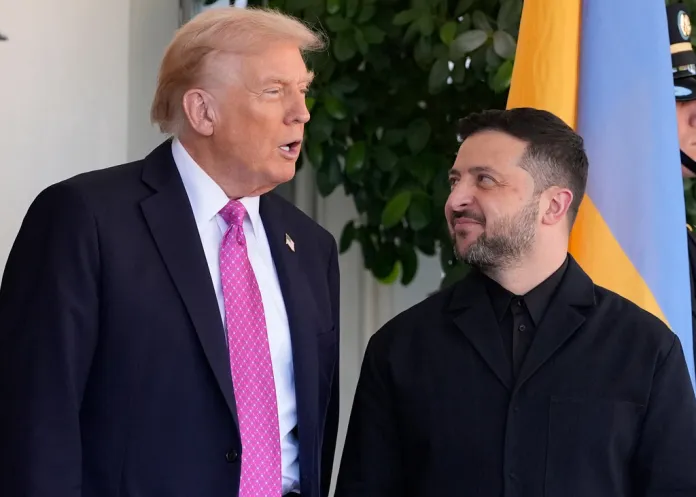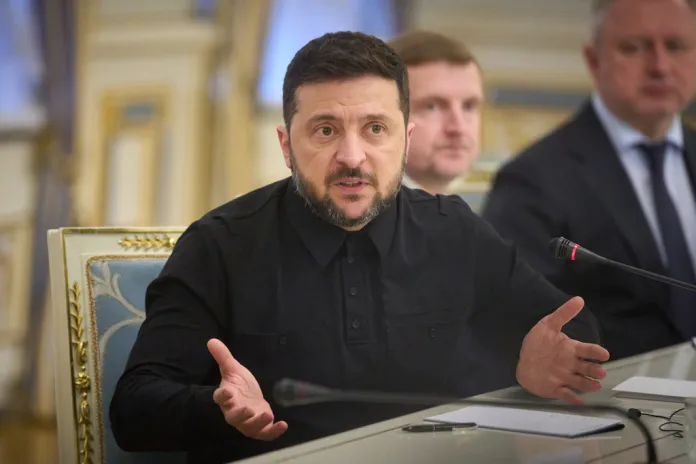Ukraine braces for escalations as Russia peace talks hit impasse
ukraine is preparing for a important escalation in conflict as it anticipates a major offensive from Russian forces during the summer. This assessment comes from Ukrainian President Volodymyr Zelensky, who indicated that as the window for a favorable peace closes in early 2025, intelligence suggests that Russia is intensifying efforts in the eastern Donetsk region, aimed at solidifying its recent gains.
Despite various peace overtures, the conflict has remained mired in deadlock due too incompatible positions between Kyiv and Moscow. Analysts believe that the anticipated Russian summer offensive could become one of the most ambitious efforts since the war’s onset in 2022, focusing on capturing fortified towns while keeping Ukrainian forces pinned down.
Key developments in the war include increased Russian use of advanced drone tactics and artillery, emphasizing an attritional warfare strategy that has led to heavy losses on both sides, particularly affecting Ukrainian military logistics and resilience. Russia’s escalation in drone production and tactics has improved its battlefield efficiency, creating significant challenges for Ukraine as it seeks to maintain its defenses against increasingly relentless assaults.
the dire situation for Ukraine is compounded by resource shortages and economic difficulties, as its military struggles to sustain operations against a numerically superior Russian force.As the conflict transitions towards a more technologically driven battlefront, the strategic landscape may experience dramatic changes, with the potential for humanitarian crises looming amid rising hostilities.
Ukraine braces for massive summer escalations as Russia peace talks hit an impasse
Ukraine‘s battlefield fortunes continue to deteriorate as Kyiv braces for a major summer offensive from Russian forces.
President Donald Trump’s ambitious goal of ending the Russia-Ukraine war upon taking office failed to pass, held up by the irreconcilable visions of Kyiv and Moscow. With the window for a favorable peace closing in the first half of 2025, Ukrainian intelligence now believes Russia will launch a massive summer offensive to cement its gains. Ukrainian President Volodymyr Zelensky outlined the country’s assessment in a May 26 address.
“We can see from the information that our intelligence is gathering and from open data that Putin and his entourage have no plans to end the war — there is no evidence that they are seriously considering peace and that they are seriously considering diplomacy,” he said.
“On the contrary, there is a lot of evidence that they are preparing new offensive operations,” Zelensky added.
Ukrainian military officials and analysts told the Washington Post that the offensive is expected to be directed against Ukraine’s eastern Donetsk Oblast, the most heavily fortified area of the front, rather than opening up new fronts elsewhere. Mykola Bielieskov, a research fellow at Ukraine’s National Institute for Strategic Studies, told the outlet that the Kremlin is likely to prioritize the fortress towns of Kostiantynivka and Pokrovsk while trying to pin down Ukrainian forces along the border with smaller incursions into the Kharkiv and Sumy oblasts.
Putin announced the beginning of operations to establish a buffer zone along the border of the two regions, looking to avert further Ukrainian incursions such as those against Kursk last year. Ukrainian intelligence shows an estimated 125,000 Russian troops are stationed on the border of Sumy and Kharkiv.
Russia has maintained momentum since its victory in the Battle of Avdiivka in February last year, but analysts have noted a watershed change over the past few months. After fully evicting Ukrainian troops from the Kursk Oblast in March, several tactical and technological developments appear to signal a new kind of war, one much better suited to Russia.
The war in Ukraine is now largely unrecognizable from what it was when it launched in February 2022. While the early months of the war saw decisive, major armor and troop movements across great distances, the past two years have been a largely attritional war decided by artillery, airstrikes, and, increasingly, drones.
Former Ukrainian military head Valery Zaluzhny noted last week that Russia has been waging an attritional war since the end of 2023, ostensibly explaining its lack of major territorial gains.
The Telegraph outlined what is termed Russia’s “Triple Chokehold” tactic. This battlefield maneuver involves pinning Ukrainian soldiers with repeated assaults, then eviscerating them with first-person view drones and massive glide bomb strikes. FPV and mine-laying drones closely monitor Ukrainian troops, preventing movement and cutting off avenues for escape, while the glide bombs pulverise entrenched positions.
The glide bombs are especially deadly, allowing Moscow to convert its vast arsenals of large Soviet-era bombs into guided munitions. The combination of the three largely neutralizes any simple way to respond.
“Digging in and all those protective measures are excellent for reducing attrition by artillery or FPVs, yet glide bombs will destroy those fortifications and bury people,” Nick Reynolds, research fellow for land warfare at the Royal United Services Institute, told the outlet.
Russia plans to produce 75,000 glide bombs throughout 2025, according to the RUSI, amounting to 205 per day.
“Rates of Russian production and employment of glide bombs and FPV drones has greatly increased as the war has gone on,” John Hardie, the deputy director of the Russia Program at the Foundation for Defence of Democracies, told the Telegram.
FPV drones have come to encapsulate the war, and Russia appears to have taken the upper hand in their use and production. According to a report from the Sunday Times, Russia has “taken the lead in the drone race,” outproducing Ukraine in the manufacture and use of FPV drones. Its mass production of fiber optic variants of FPV drones has been especially effective, making them impervious to electronic warfare. Russian troops have also shown the ability to adapt to battlefield conditions rapidly.
“The changes posed by drones are so fast that concepts we implemented just a month ago no longer work now,” an infantry battalion commander with the 13th Khartiia brigade, callsign “Cuba,” told the outlet. “We live in a space of perpetual fast adaptation. In the past week alone, Russian drone strike ranges have increased by [2.5 miles].”
Upon their introduction, FPV drones were only a risk at the front line, but innovations have since greatly expanded their range. A “grey zone” of over 6 miles now extends behind Ukrainian lines, marking the area in which FPV drone attacks are common.
“No other weapon type has changed the face of the war here so much or so fast as the FPV drone,” a Ukrainian lieutenant, “Stanyslav” from the 93rd Mechanised Brigade, told the Sunday Times. “Almost any vehicle within [3.1 miles] of the front is as good as finished. Anything moving out to [6.2 miles] is in danger. Drone strikes at [9.2 miles] or [12.4 miles] are not that unusual.”
The lieutenant even declared that the swarm of drones had rendered tanks and armored personnel carriers obsolete at the front.
“Russian drones swarm our armoured vehicles whenever they get near the zero point,” he added. “The days of the tank are truly over.”
The omnipresent presence of drones has had its greatest effect on logistics. Troops must now spend months at the front, rather than weeks, inflicting an immense psychological toll.
Until recently, armored personnel carriers would drop off soldiers less than half a mile from the front line, with soldiers walking the rest of the short distance. With armored vehicles serving as perfect targets for Russian drones, pickup trucks now drop soldiers off several miles from the front line, to which soldiers must hike at night. Resupply must be done by drone.
This attritional fight has stretched the Ukrainian military to its limit. While Russia also incurs heavy losses, it has a much larger manpower and resource pool to draw from.
To make matters even worse, Russia has begun smashing Ukraine’s industry, having degraded its air defenses through destruction of batteries or depletion of ammunition. The growing weakness of Ukrainian air defenses was illustrated when they failed to intercept any of the nine ballistic missiles fired by Russia over the weekend.
Ukraine is completely out of ammunition for its two vital missile defense SAMP/T batteries, the Franco-Italian version of the Patriot, according to sources speaking with Le Monde. It’s almost or completely out of ammunition for its short-range anti-aircraft Crotale system, and its stocks of Patriot missiles have grown wearily thin. State Secretary Marco Rubio has indicated that the United States has no more Patriot missiles to give. Russia’s withering drone and missile assaults against Ukrainian infrastructure, already at an all-time high, are likely to increase in number and ferocity in the ensuing months.
Zaluzhny outlined the dire situation Ukraine finds itself in.
“In our current conditions, and for us, this is a huge shortage of human resources and the catastrophic economic situation in which we find ourselves, we can only talk to you about a high-tech war for survival, where a minimum of human resources, a minimum of economic means are used to achieve maximum benefit. Ukraine is not capable of another war in the conditions of demography and economy, and cannot even think about it,” he said.
TRUMP SHARPENS PUTIN CRITICISM IN WARNING AS HE WEIGHS SANCTIONS ON RUSSIA: ‘PLAYING WITH FIRE!’
Russia has largely refrained from “big arrow” offensives since the early months of the war, instead eking out small territorial advances. Its attritional approach has allowed it to incur smaller losses than usual, though these have still been significant. The goal of an attritional strategy isn’t to go on forever, however, but rather to weaken the enemy to near collapse, at which point a decisive offensive can be mounted. Whether Moscow believes the chance has arrived this summer remains to be seen.
The Atlantic Council hinted that this possibility is on the table, warning that “current Russian troop movements and battlefield dynamics indicate that the coming summer offensive may be one of the largest and most ambitious of the entire war.”
" Conservative News Daily does not always share or support the views and opinions expressed here; they are just those of the writer."




